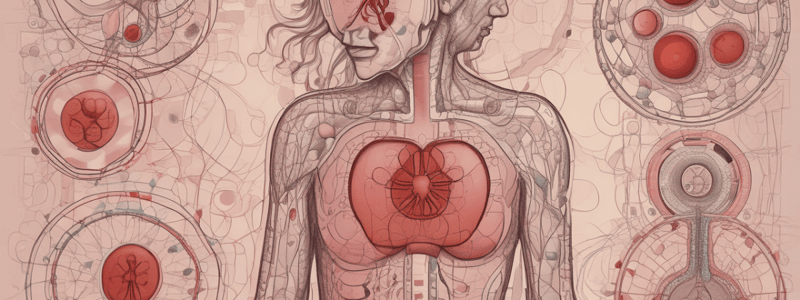Podcast
Questions and Answers
What is the main characteristic of Reactive Leukocytosis?
What is the main characteristic of Reactive Leukocytosis?
- Uncontrolled proliferation of extremely immature blast WBC's
- Dysregulated and uncontrolled proliferation of maturing WBC's
- Non-Cancerous increased in WBC in reaction to an infection, inflammation or stress (correct)
- Exposure to certain environmental factors leading to oncogenic mutation of B or T Lymphocytes
What is the mechanism of action of Acute Leukemia?
What is the mechanism of action of Acute Leukemia?
- Dysregulated and uncontrolled proliferation of maturing WBC's
- Exposure to certain environmental factors leading to oncogenic mutation of B or T Lymphocytes
- Uncontrolled proliferation of extremely immature blast WBC's (correct)
- Left shift during acute bacterial infection
What is the primary cause of Crowding out of Normal hematopoetic cells in Acute Leukemia?
What is the primary cause of Crowding out of Normal hematopoetic cells in Acute Leukemia?
- Extremely immature blast WBC's (correct)
- Oncogenic mutation of B or T Lymphocytes
- Neutrophilic Leukocytosis
- Maturing but Dysfunctional WBC's
What is the role of Oncogenes in Acute Leukemia?
What is the role of Oncogenes in Acute Leukemia?
What is the primary difference between Acute Leukemia and Chronic Leukemia?
What is the primary difference between Acute Leukemia and Chronic Leukemia?
What is the effect of Tumor Suppressor genes deactivation in Chronic Leukemia?
What is the effect of Tumor Suppressor genes deactivation in Chronic Leukemia?
What is the general mechanism of action of Hodgkin Lymphoma?
What is the general mechanism of action of Hodgkin Lymphoma?
What is the result of uncontrolled proliferation of cancerous lymphocytes in Hodgkin Lymphoma?
What is the result of uncontrolled proliferation of cancerous lymphocytes in Hodgkin Lymphoma?
What is the characteristic of WBC's in Chronic Leukemia?
What is the characteristic of WBC's in Chronic Leukemia?
What is the primary consequence of Anemia, Thrombocytopenia, Leukopenia in Acute Leukemia?
What is the primary consequence of Anemia, Thrombocytopenia, Leukopenia in Acute Leukemia?
What is the primary characteristic of abnormal cells in Hodkins lymphoma?
What is the primary characteristic of abnormal cells in Hodkins lymphoma?
What is the common presentation of patients with lymphoma?
What is the common presentation of patients with lymphoma?
What is the primary cause of Hepatosplenomegaly in lymphoma patients?
What is the primary cause of Hepatosplenomegaly in lymphoma patients?
What is the typical finding in a Bone marrow biopsy of lymphoma patients?
What is the typical finding in a Bone marrow biopsy of lymphoma patients?
What is the specific genetic abnormality found in Chronic Myeloid Leukemia?
What is the specific genetic abnormality found in Chronic Myeloid Leukemia?
What is the result of the translocation of chromosomes 9 and 22 in Chronic Myeloid Leukemia?
What is the result of the translocation of chromosomes 9 and 22 in Chronic Myeloid Leukemia?
What is the primary difference between Hodkins and Non-Hodkins lymphoma?
What is the primary difference between Hodkins and Non-Hodkins lymphoma?
What is the result of Leukopenia in lymphoma patients?
What is the result of Leukopenia in lymphoma patients?
What is the primary function of Lymph node biopsy in lymphoma diagnosis?
What is the primary function of Lymph node biopsy in lymphoma diagnosis?
What is the commonality between the symptoms of lymphoma and leukemia?
What is the commonality between the symptoms of lymphoma and leukemia?
Flashcards are hidden until you start studying
Study Notes
Disease Comparison
- Reactive Leukocytosis: a non-cancerous increase in WBC in response to infection, inflammation, or stress, with no left shift.
- Acute Leukemia: cancer of developing WBC in the bone marrow, characterized by uncontrolled proliferation of extremely immature blast cells.
- Chronic Leukemia: cancer of maturing WBC in the bone marrow, characterized by dysregulated and uncontrolled proliferation of maturing WBC.
- Hodgkin Lymphoma: cancer of lymphocytes originating in the lymphatic system, characterized by abnormal Reed-Sternberg cells.
- Non-Hodgkin Lymphoma: cancer of lymphocytes originating in the lymphatic system, characterized by malignant T or B lymphocytes.
Mechanism of Action
- Reactive Leukocytosis: Neutrophilic Leukocytosis during acute bacterial infection, or Acute Inflammatory process.
- Acute Leukemia: mutated genes in bone marrow activate oncogenes, leading to uncontrolled proliferation of blast cells.
- Chronic Leukemia: tumor suppressor genes are deactivated, leading to excessive proliferation of maturing WBC.
- Hodgkin Lymphoma: exposure to environmental factors leads to oncogenic mutation of B or T lymphocytes, causing uncontrolled proliferation.
- Non-Hodgkin Lymphoma: exposure to environmental factors leads to oncogenic mutation of B or T lymphocytes, causing uncontrolled proliferation.
Presentation
- Acute Leukemia: fatigue, easy bleeding, frequent infections, pain and tenderness of bones, abdominal fullness, and hepatosplenomegaly.
- Chronic Leukemia: fatigue, fever, weight loss, anorexia, hepatosplenomegaly, and recurrent infections.
- Hodgkin Lymphoma: lymphadenopathy, B-symptoms, and structural compression of normal surrounding tissues.
- Non-Hodgkin Lymphoma: lymphadenopathy, B-symptoms, and structural compression of normal surrounding tissues.
Diagnostic Tests
- Acute Leukemia: CBC, blood smear, and bone marrow biopsy.
- Chronic Leukemia: CBC, blood smear, and genetic testing (Philadelphia chromosome).
- Hodgkin Lymphoma: lymph node biopsy.
- Non-Hodgkin Lymphoma: lymph node biopsy.
Patterns of Inheritance
- Chronic Leukemia: specific genetic abnormality, Philadelphia chromosome, found in CML, leads to uncontrolled cell proliferation and prevention of cell death.
Studying That Suits You
Use AI to generate personalized quizzes and flashcards to suit your learning preferences.




